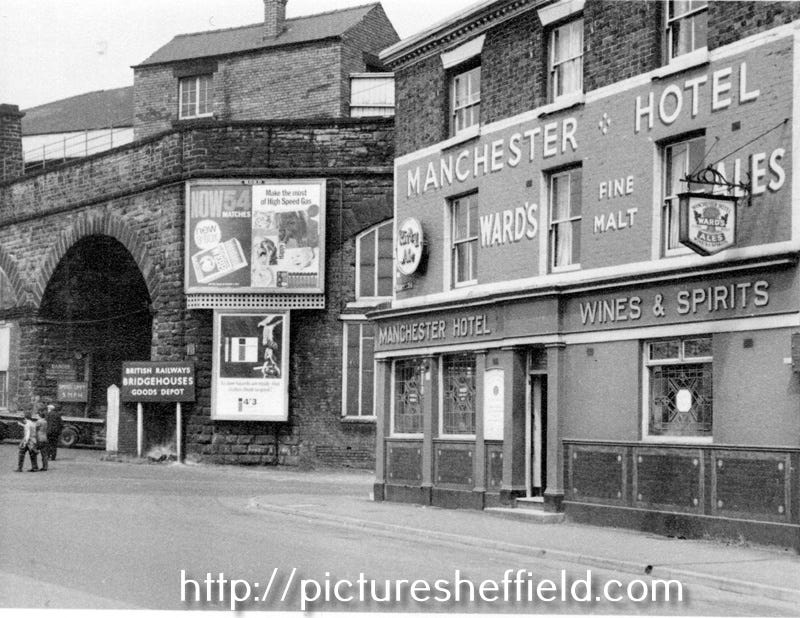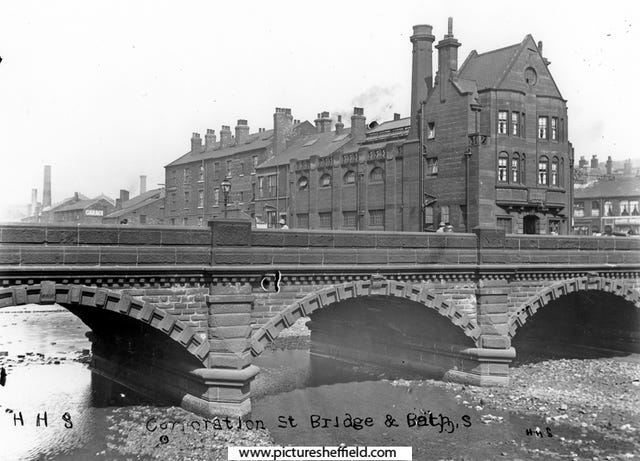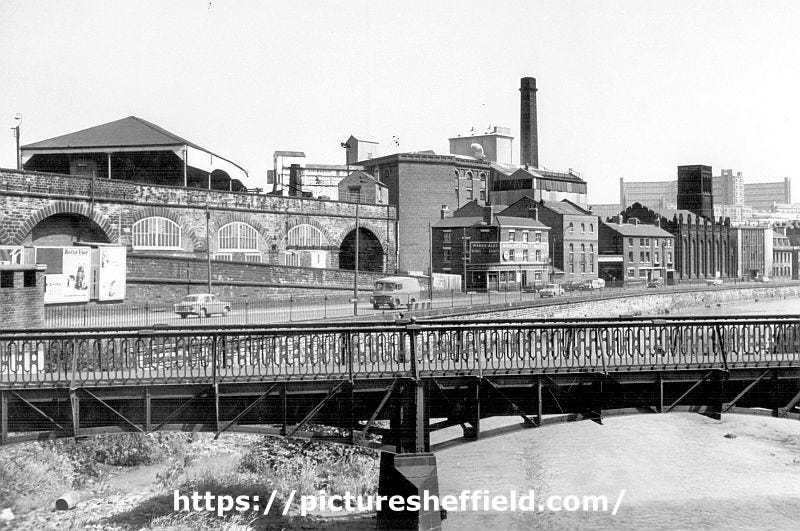‘Across the river was the suburb of Bridgehouses, and all around was verdure…’ wrote Robert Leader in 1876, quoting an older resident remembering the early nineteenth century (In ‘Reminiscences of Old Sheffield: Its Streets and Its People’). Many parts of Sheffield have changed - and some dramatically. Housing clearance schemes or new buildings and roads can change places beyond recognition. Sometimes entire areas of the city seem to have gone, maybe having been swallowed up by the surrounding areas (or it might just be that the name of an area has changed), but this is a once important part of Sheffield that has almost completely passed into history. The area has been through different phases of being green, industrial, and residential. It has been an important railway hub, and the location for one of the newly formed Town Council’s first major public works in the 1850s. Bridgehouses had the bridge and houses - but also shops, pubs, a Post Office - and now there only really remains the Bridgehouses Roundabout, complete with a mostly redundant footbridge at the centre.
The footbridge in the middle of the roundabout must be the ‘bridge’ part of the name - or is it? Peter Harvey in ‘Street Names of Sheffield’ says that the name pre-dates any bridge there, and is more likely to reference Lady’s Bridge nearby. Robert Leader in his ‘Sheffield in the Eighteenth Century’ makes a similar point, asking why the name if there was no bridge? What complicates matters is that there has been a crossing at the site for a long time; a few different bridges, but also likely a ford or stepping stones before then too - maybe the bridge that gave the area its name was something more rudimentary? There was a wooden bridge first recorded being repaired in the 1720s, and in 1795 the region’s first iron bridge replaced it. Whether Bridgehouses gets its name from the footbridge or not, the bridge is central to the area’s story. It has formed an important crossing for centuries - important enough not just to be made from iron in 1795, but also to be re-built following being swept away by the 1864 Great Flood.
The Iron Bridge at Bridgehouses by W. Botham, 1804
Bridgehouses was really put on the map when it became the first Sheffield terminus of the new rail line to Manchester, which opened in July 1845. The line was soon extended to a larger station at Sheffield Victoria, and Bridgehouses then became an extensive goods yard, remaining so until 1965 (as did nearby Wicker Station). When it was in passenger service the footbridge would have provided access to the station for many. The goods yard covered a large site - up to the end of Nursery Street on land which is now under the ring road, and reaching Chatham Street at the other end. This would have been a large employer - bringing plenty of custom to the nearby pubs, shops, and cafes. The intended passengers had been replaced by the rail workers.
Manchester Hotel (recently ‘The Harlequin’) and Bridgehouses Goods Yard in 1972
When the station was opened the footbridge was the only crossing of the River Don between Lady’s Bridge and Ball Street bridge, something that was to change in the mid-1850s with the construction of Borough Bridge, and the road that connected it to the town centre; Corporation Street. The 1852 Sheffield Bridges and Streets Act gave assent for several new developments, which were amongst the first major works carried out by the Town Council. The first proposal listed in the Act was ‘a bridge at or near the Iron Bridge’, which was to became Borough Bridge. It is interesting that the footbridge kept the name ‘Iron Bridge’ for some time after construction, denoting its historic status from 1795 - also the street name ‘Corporation Street’ and the bridge name too, demonstrate the pride of the authority in their work. The local press at the time reported that the trowel that dug the first piece of earth was buried at one corner of the bridge, enclosed with a copy of the parliamentary act signed by various local dignitaries along with the borough seal (Sheffield Independent, March 12th 1853).
On the corner of Borough Bridge, where the Riverside pub now stands, were the old Corporation Street baths from 1879 until the 1960s. Many Sheffield folk learned to swim there as kids, and in the early days of the baths they provided washing facilities for local people too. Accounts of the pool describe how steamy and hot it could be (as the boilers were coal fired), and also how small the pool was - it is said that gaining school swimming certificates meant doing one and a half or two lengths to make up the required yards! Going to Bridgehouses for lots of young people over many years would have meant going to the swimming pool - and no doubt also providing another source of customers for the nearby shops.
Borough Bridge between the wars with Corporation Street baths behind
The footbridge and roundabout are bordered by Mowbray Street on the Neepsend side, Nursery Street leading to Wicker, and Chatham Street heading up the hill towards Pitsmoor. The road between the Mowbray Street and Nursery Street used to be called simply ‘Bridgehouses’, and had shops and pubs along it serving the residents and workers of the area. Both the Iron Bridge and Borough Bridge were hemmed in by buildings more than they are today, with Bridgehouses Roundabout the only part of the old road still officially retaining the name. There are still plenty of workplaces on both sides, and places to eat and drink, but Chatham Street (with the retaining wall of the old Bridgehouses goods yard on the right) had been almost completely cleared until the recently opened apartments were built.
‘Then and now’ looking up Chatham Street from Bridgehouses
There have been several pubs in the immediate vicinity. There was a Bridge Inn adjacent to the footbridge as early as 1818, which closed in 1887, later there opened the Manchester Hotel (more recently called The Harlequin) at the entrance of the goods yard, which opened in 1846 shortly after the passenger station, and the Brown Cow (now The Riverside) next to the old swimming baths, which dated from 1871. Incidentally The Manchester Hotel became The Harlequin after another pub of the same name on nearby Johnson Street was closed. The buildings that included the old Bridge Inn (which was on the current roundabout) housed shops well into the second half of the twentieth century, before making way for the ring road. Another indicator of the suburb’s status and identity was the old Bridgehouses Post Office, situated a few doors along Mowbray Street from the Brown Cow.
The Brown Cow and the closed Bridgehouses Post Office in the mid-1980s
The Iron Bridge is certainly a survivor - not the original structure granted, but the latest incarnation and on an important historical site. The Borough Bridge structure is even older, having survived the 1864 Great Flood (unlike its neighbour). The footbridge is a real link with the area’s past, and with the name too - a part of Bridgehouses survives as long as the footbridge does. The bridge has been looked after by a friends group (link to Facebook page at the bottom of the page) for a decade or so now, and with trees being planted on the roadside by the council the roundabout is bringing a green look back to Bridgehouses now.
In recent years there have sprung up several new apartment blocks close by, and it may be that almost as many people live in the old Bridgehouses area now than they ever did. I suspect now that their address will be more like Millsands, Neepsend, or even Kelham Island, instead. Having said that the new block by Chatham Street is called ‘Great Central’ - nicely recalling the area’s railway history. Looking back the loss of Bridgehouses’ identity may well have started with the closure of the old goods yard, so I think it appropriate and welcome that something of that remains in the name. I hope some of the area’s new residents visit the old footbridge on their doorstep and walk across it, or just take the chance to stand over the Don - just as many hundreds of thousands of Sheffield folk have done over the centuries, and in doing so help keep a little of the spirit of lost Bridgehouses alive.
https://www.facebook.com/groups/983827418318256










